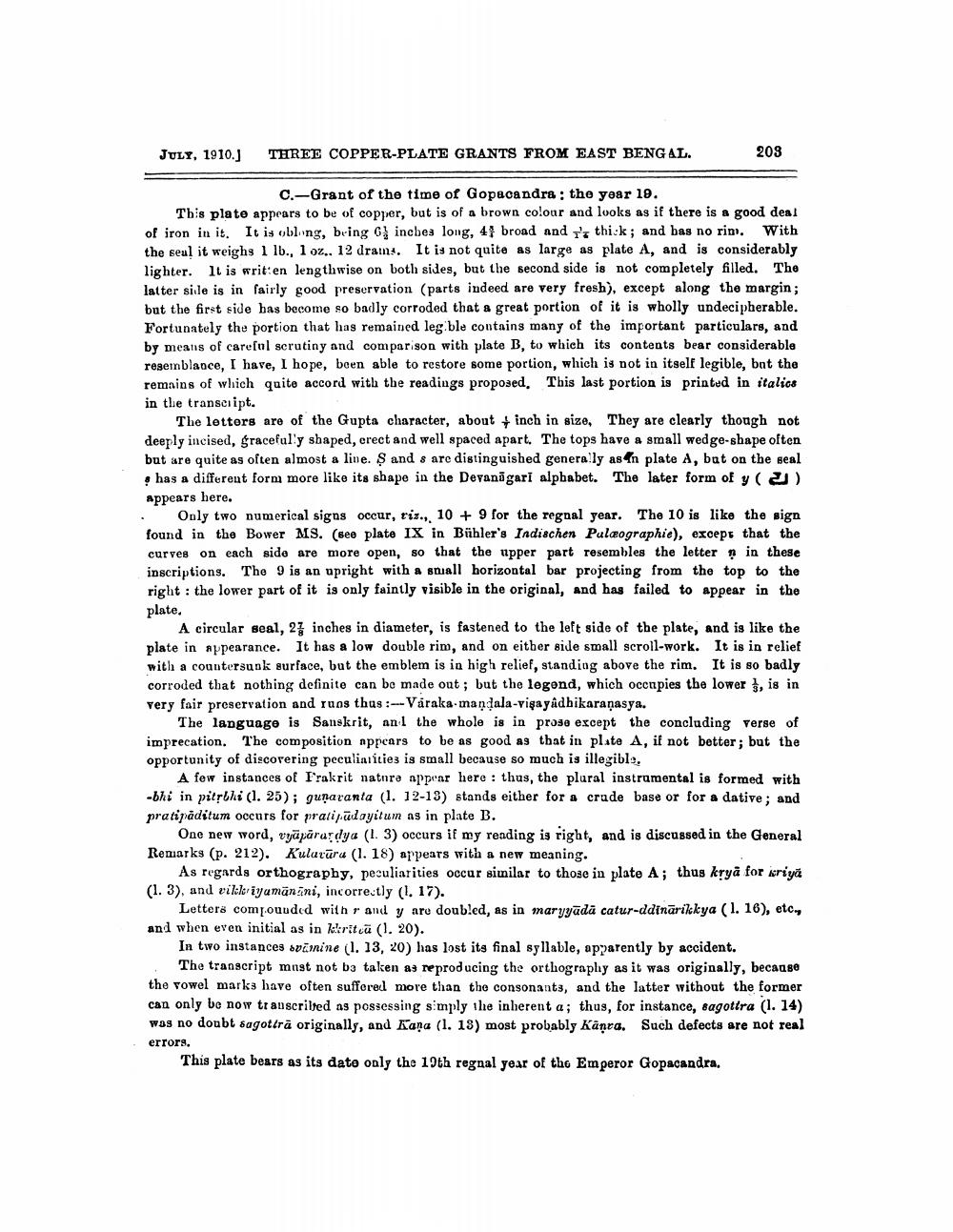________________
JULY, 1910.]
THREE COPPER-PLATE GRANTS FROM EAST BENGAL.
203
C.-Grant of the time of Gopacandra : the year 19. This plate appears to be of copper, but is of a brown colour and looks as if there is a good deal of iron in it. It is obling, being Ginebes long, 44 broad and i't thick; and bas no rim. With the seul it weighs 1 lb., 1 oz.. 12 drams. It is not quite as large as plate A, and is considerably lighter. It is writ:en lengthwise on both sides, but the second side is not completely filled. The latter side is in fairly good preservation (parts indeed are very fresh), except along the margin; but the first side has become so badly corroded that a great portion of it is wholly undecipherable. Fortunately the portion that has remained leg ble contains many of the important particulars, and by means of careful scrutiny and comparison with plate B, to which its contents bear considerable resemblance, I have, I hope, been able to restore some portion, which is not in itself legible, but the remains of which quite accord with the readings proposed. This last portion is printed in italics in the transcript.
The letters are of the Gupta character, about inch in size. They are clearly though not deeply incised, gracefully shaped, erect and well spaced apart. The tops have a small wedge-shape often but are quite as often almost a line. $ and s are distinguished genera ly as In plate A, but on the seal
has a different form more like its shape in the Deyanāgari alphabet. The later form of y(J) appears here.
Only two numerical sigas occur, ris., 10 + 9 for the regnal year. The 10 is like the sign found in the Bower MS. (see plate IX in Bühler's Indischen Palæographie), except that the curves on each side are more open, so that the upper part resembles the letter in these inscriptions. The 9 is an upright with a small horizontal bar projecting from the top to the right : the lower part of it is only faintly visible in the original, and has failed to appear in the plate.
A circular seal, 27 inches in diameter, is fastened to the left side of the plate, and is like the plate in appearance. It has a low double rim, and on either side small scroll-work. It is in relief with a countersunk surface, but the emblem is in high relief, standing above the rim. It is so badly corroded that nothing definite can be made out ; but the legend, which occupies the lower }, is in very fair preservation and runs thus:--Váraka-mandala-vişa yâdbikaraṇasya.
The language is Sanskrit, anl the whole is in prose except the concluding verse of imprecation. The composition appears to be as good as that in plate A, if not better; but the opportunity of discovering peculiarities is small because so much is illegibls.
A few instances of Prakrit natura appear here : thus, the plural instrumental is formed with -bhi in pitbki (I. 25); gunaranta (1. 12-13) stands either for a crude base or for a dative; and pratipaditum occurs for pratipadayitum as in plate B.
One new word, vyāpāra,dya (1. 3) occurs if my reading is right, and is discussed in the General Remarks (p. 212). Kulatūra (1. 18) appears with a new meaning.
As regards orthography, peculiarities occur similar to those in plate A; thus kryā for kriya (1.3), and vileleriyumānani, incorrectly (1. 17).
Letters compouuded with r and y are doubled, as in maryyādā catur-ddinārikkya (1. 16), etc., and when even initial as in kritcā (1. 20).
In two instances spännine (1. 13, 20) has lost its final syllable, apparently by accident.
The transcript must not be taken a reproducing the orthography as it was originally, because the vowel marks have often suffered more than the consonants, and the latter without the former can only be now transcrilted as possessing simply the inherent a; thus, for instance, sagotira (1. 14) was no doubt sagottra originally, and Kaņa (1. 13) most probably Kaņra. Such defects are not real errors.
This plate bears as its date only the 19th regnal year of the Emperor Gopacandra.




